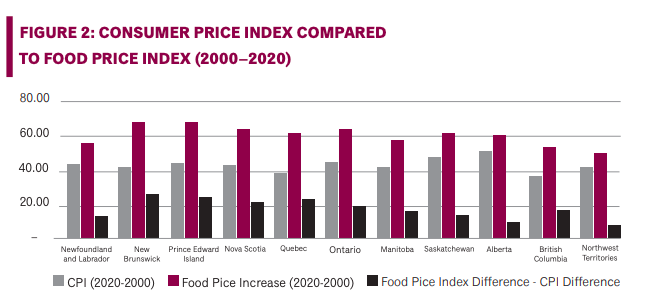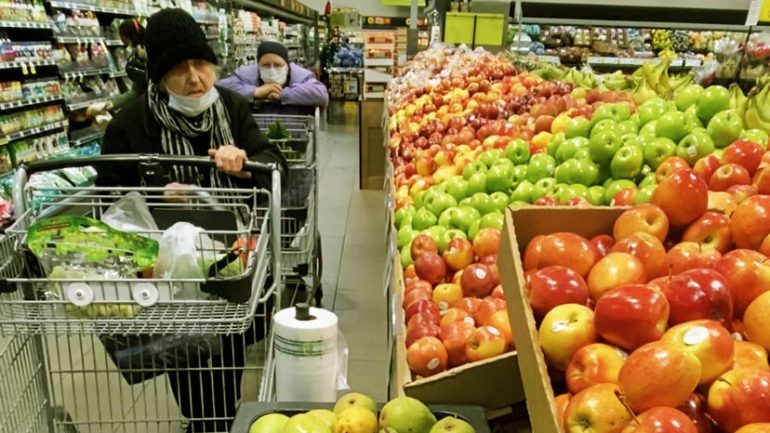Average Canadian household to spend $695 more on groceries in 2021, the report says
December 10, 2020, 1:33 pm ASTLast Updated: December 10, 2020, 1:33 pm
Canada’s annual Food Price Report predicts a significant rise in food costs as the industry faces a massive shift in demand and food security challenges during COVID-19.
The report, released Tuesday, states an average four-person Canadian family should expect to pay $13,907 for food in 2021, up $695 from this year. That doesn’t include eating out at restaurants. The pandemic affected the entire agri-food chain, from farm gate to consumers, and shifted consumer demand from food service to food retail.
The Signal spoke to one of the authors of the report, Alyssa Gerhardt, in the Faculty of Applied Social Sciences at Dalhousie University, to learn about specific factors contributing to the overall change in food prices and the imbalance in the food supply chain.
Q: The pandemic has changed the consumer demand from food service to food retail, according to the report. How did this change affect the food supply chain?
The ratio of food retail to food service changed quite significantly. Before the pandemic, 62 per cent of house budget was spent on food retail and 38 per cent was spent on food service. When we looked in May 2020, right before things started to slowly reopen, we were looking at 91 per cent of household budget spent on food retail but only nine per cent was spent on food service. That’s a significant change.
Like you said, consumer demand shifted mainly to food retail. What that means to a distributor is it poses quite a few problems because we’ve to think about distribution minds. Some are only directed to food service and some are only directed to food retail and then you have hybrids that would service both. Big challenges that we saw for distributors was particularly in packaging. What we would package for food retail looks quite different than what we package for food service. Think of like even an example like butter. You may have little tiny butters packaged for food for restaurant for each individual customer when that looks different in a grocery store. So that was one problem. And the other, especially I think affected by that shift in demand was for bulk product. A lot of these distributors are selling bulk to restaurants and they’ve to significantly change to cater to food retail. And other than Costco, a lot of grocery stores don’t offer bulk products to customers. Those were some of the challenges the supply chain was facing.
Q: If the distributors are doing the repackaging to cater to the shift in demand, how does that affect what the consumer pays for the product? Is the repackaging cost factored into the consumer price?
Those costs are definitely factored in, but we should also think about other costs that companies are facing right now, including increased sanitization, personal protective equipment for workers and in some facilities, there’s extra cost with having to distance workers and maybe there’s a loss in efficiency and capacity. So those costs are potentially being passed on to consumers. We’ve also seen with e-commerce, people are investing in infrastructure because there is an increase in demand. So those costs to businesses may also be passed on to the consumers. There are many factors why food prices are going up. Distribution prices are just one factor. There are many other factors happening in the food supply chain beyond distribution that is affecting the prices of food going up in the retail. Some of those factors are: In 2020, COVID had impacted where we saw migrant worker labour shortages on farm. We saw a very low Canadian dollar at one point, which affected our purchasing power of imported vegetables. So, it’s not just one part of the supply chain really driving up the price, there are many different factors combined.
Even though Canadians aren’t eating out as much, they’re still paying higher food price buying food to cook but there’s also a demand for online services and there’s a lot of fees associated with those services. So, you could speculate that because they’re not eating at restaurants, they’re actually saving money. But because of the shift in consumer demand during the pandemic, that is costing Canadians more. Maybe it doesn’t completely even out, but there’s many factors to be considered there. We found that with the report this year — it was an unprecedented and unusual year — it was really hard to think through this report because we’ve never been in this situation before. We know our food supply chain is quite resilient. We’ve adapted really well to challenges and lessons that have happened. But still the future is uncertain and so it definitely was difficult given the rapidly changing circumstances, and we do feel good about predictions we made in terms of accuracy.

Q: How does this change in demand jeopardize food security?
When we’re talking about food and security, we’re not necessarily talking about food supply. Our food supply is secure, and we’ve seen that over the course of the pandemic. Like I said, buyers in the chain have adapted well. When we’re talking about food and security, we’re talking about consumers and their ability to purchase food. Purchasing power of consumers is going to be affected and continued to be affected by unemployment, under employment, and just overall economic hardship they’re facing. When we’re talking about food and security, we’ve to now look at it more from the end of consumer and their ability to access and afford food rather than the ability of the chain to make sure we have the food.
Q: According to the report, one in five Canadians started home gardens this year amid the pandemic. Do you think this pattern could start alleviating the food insecurity concern?
It’s uncertain because what we found from the gardening study was that more Canadians are starting to garden at home. We did that exercise particularly in Atlantic Canada, but also we found in that study that people growing their own food are sourcing their food not only from the garden. They are still going to the grocery store … Is that more of a leisure activity and people have more time to do those things or is it happening out of necessity that they need to grow their own food to eat? If it’s a leisure activity, it’s not going to necessarily alleviate food insecurity for the lowest income population in our society.
Q: What about macroeconomic factors such as nationalist agricultural policy, the climate and the plant-based movement? How are they specifically contributing to food insecurity?
We definitely have identified macroeconomic factors that are going to play a role in food price increases and that does include climate change. We did look at nationalist policies as well. And I think there was a lot of questions around the U.S. election because if Trump was re-elected, he has a tendency toward more trade protectionist policy and also nationalist policy. So, that could impact our ability to import food from the States. But that could also be implemented by other countries in the world. So, where we do rely on imports that is something to think about.
But looking at climate change, the climate change isn’t waiting for us because we’re in a pandemic. There are still record droughts, record heat this year that have posed a lot of challenges to growing food and global food supply. All of those factors are going to also impact us in Canada. Even though our supply chain may be relatively stable and safe, we have to always be thinking globally as well. For example, the California wildfires. We import a lot of vegetables from California when they’re out of season here. So, all of those like climate impacts factors, they will have an effect on food prices here as well.
I think there’s a number of factors that go into someone’s decision to adopt a plant-based diet. I think that climate change is probably a big factor because we do know that industrial meat production can be harmful to the environment. I do think that is probably a motivation. I think it’s concerning we’re asking people to adopt plant based and sustainable diets when we’re not necessarily making them accessible to everyone and affordable to everyone. In 2019, Canada’s food guide came up with new guidelines and they heavily emphasized plant-based food. But when you’re asking someone to adopt this style and vegetable prices are going up 6.5 per cent, is that accessible to everyone and affordable to everyone? That’s something we need to think about.
This piece has been edited and condensed for clarity.
Have a story idea? Let us know

Devoted web advocate. Bacon scholar. Internet lover. Passionate twitteraholic. Unable to type with boxing gloves on. Lifelong beer fanatic.






